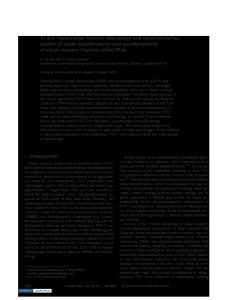Cracking and Phase Transformation in Silicon During Nanoindentation
- PDF / 417,390 Bytes
- 6 Pages / 612 x 792 pts (letter) Page_size
- 42 Downloads / 340 Views
U8.15.1
Cracking and Phase Transformation in Silicon During Nanoindentation Jae-il Jang 1,2, Songqing Wen 1, M.J. Lance 2, I.M. Anderson 2, and G.M. Pharr 1,2 1 The University of Tennessee, Dept. of Mater. Sci. & Eng., Knoxville, TN 37996-2200, U.S.A. 2 Oak Ridge National Laboratory, Metals and Ceramics Division, Oak Ridge, TN 37831, U.S.A. ABSTRACT Nanoindentation experiments were performed on single crystals of (100) Si using a series of triangular pyramidal indenters with centerline-to-face angles in the range 35.3° to 85.0°. The influences of the indenter geometry on cracking and phase transformation during indentation were systematically studied. Although reducing the indenter angle reduces the threshold load for cracking and increases the crack lengths, c, at a given indention load, P, the frequently observed relation between P and c3/2 is maintained for all of the indenters over a wide range of load. Features in the nanoindentation load-displacement curves in conjunction with Raman spectroscopy of the crystalline and amorphous phases in and around the contact impression show that the indenter geometry also plays a role in the phase transformation behavior. Results are discussed in relation to prevailing ideas about indentation cracking and phase transformation in silicon. INTRODUCTION During nanoindentation, material underneath the indenter experiences highly localized stresses and strains. In silicon, these high stresses cause plastic deformation not only by dislocation activity, but also by pressure-induced phase transformations to denser crystalline and amorphous forms. Indentation with sharp pyramidal indenters also causes cracking of the type often used in the measurement of fracture toughness. Recent work has shown that these phenomena play an important role in material removal processes during machining and facilitate precision machining of silicon by single point diamond turning. In order to better understand the physics of these processes as they relate to machining, nanoindentation studies with pyramidal indenters having centerline-to-face angles, Ψ, in the range 35.3° to 85.0° were conducted on single crystals of (100) silicon. The results reported here are the initial results of a much larger study to examine how the indenter geometry influences the cracking and phase transformation behavior. EXPERIMENTAL DETAILS Nanoindentations were made in standard wafers of (100) Si using a Nanoindenter-XP (MTS, Oak Ridge, TN). Six different triangular pyramidal indenters were employed having centerlineto-face angles, Ψ, of 35.3° (cube-corner), 45.0°, 55.0°, 65.3° (Berkovich), 75.0°, and 85.0°. Loads were varied in the range from 1 to 100 mN and loading rates from 0.5 to 5 mN/sec. After testing, all the hardness impressions were examined and measured by field-emission scanning electron microscopy (FESEM) to determine the sizes of the contact impressions and the lengths
U8.15.2
7
25
a c
6
O
35.3 O 45.0 O 55.0 O 65.3
20 3/2
[µm ]
4
10
3/2
3
15
c
a, c [µm]
5
2
5
1 0 30
0 40
50
60 O
Ψ[ ]
Data Loading...





